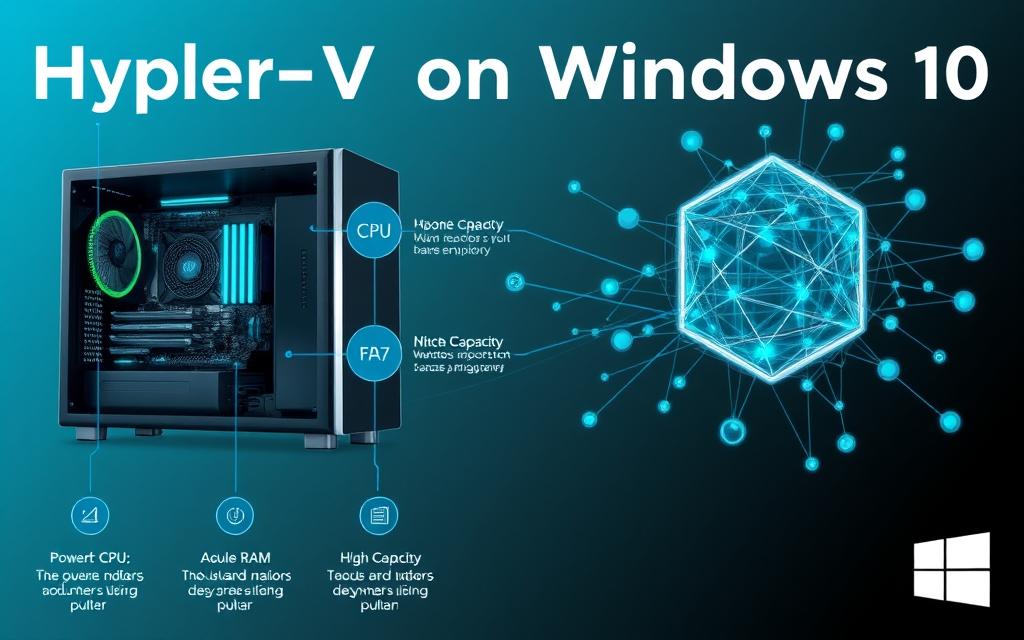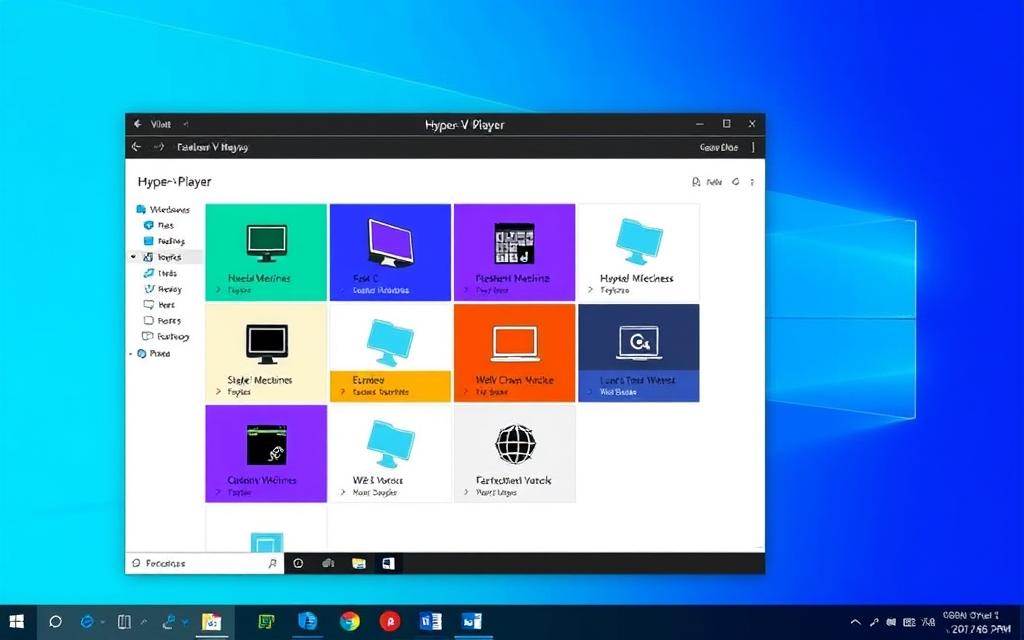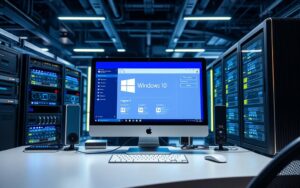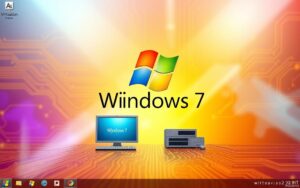Table of Contents
Hyper-V Player is key for those exploring Windows 10 virtualisation. It’s found in the Pro and Enterprise editions. It lets you make and manage virtual machines for tasks like testing software or using multiple operating systems at once. This Hyper-V tutorial is a full guide to help you start and use Hyper-V Player on your system.
The tutorial received 14 votes about installing Hyper-V on Windows 10 Home Edition, but it’s not supported there. It mainly covers the Pro and Enterprise editions, focusing on the required hardware and virtualisation capabilities. Additionally, feedback from users shows that 6 found enabling the Hyper-V Management Console instructions useful, while 3 liked the clarity on its inavailability for Home Edition.
While Hyper-V is a top choice for professionals, other options like VMWare and Oracle Virtual Box are available. Oracle Virtual Box is free and simple to install but might not fit professional needs. Hyper-V’s desktop edition mirrors its server version, making it easier for users to switch between environments. We will explore installation and virtual machine management steps next.
Introduction to Hyper-V and Virtualisation
Microsoft developed Hyper-V, a strong hypervisor that makes creating and managing virtual machines easy. This virtualisation technology lets multiple operating systems run on one physical machine. It boosts resource use and keeps applications separate. Hyper-V works directly with the CPU, marking it as a Type 1 hypervisor.
The benefits of Hyper-V shine in corporate settings where saving money and working efficiently are key. It allows a single machine to mimic different system setups without affecting the main system. This support for Windows, Linux, and FreeBSD makes for a more adaptable IT setup.
Hyper-V also has lots of features for both Windows 10 and Windows Server. Windows 10 has perks like Quick Create and a default NAT switch, making virtual machine management easier. Meanwhile, Windows Server has tools like live migration and Hyper-V Replica for businesses.
Virtual machines in Hyper-V run in their own spaces, boosting the system’s overall performance. This setup allows many VMs to run at once. However, there are limits, especially for apps that need certain hardware or precise timing.
All in all, Hyper-V is a top-notch choice in virtualisation technology. It brings a lot of benefits to different platforms, leading to smart IT management.
System Requirements for Hyper-V on Windows 10
Knowing about the Hyper-V hardware requirements is crucial for a good virtual setup on Windows 10. It’s important that your computer meets these needs before you start using Hyper-V. This ensures that the virtualisation capabilities work well and managing virtual machines becomes easy.
Essential Hardware Specifications
To get the best performance from Hyper-V on Windows 10, your computer must match these specs:
- 64-bit processor with Second Level Address Translation (SLAT)
- Support for VM Monitor Mode Extension (VT-x for Intel CPUs, AMD-V for AMD CPUs)
- A minimum of 4 GB of RAM (extra memory will be needed for guest machines)
Understanding these hardware specs is key to great Hyper-V compatibility and smooth performance. Make sure your system matches these before turning on Hyper-V.
Supported Windows Versions
Hyper-V works with certain Windows 10 editions, like Windows 10 Pro and Windows 10 Enterprise. If you have the Home edition, Hyper-V won’t be available. Windows 11 also supports Hyper-V in both its Pro and Enterprise versions. Make sure you have the right version of the operating system. For more info on Hyper-V and what it does, click here.

| Specification | Requirement |
|---|---|
| Processor | 64-bit with SLAT |
| Virtualisation Support | VM Monitor Mode Extension |
| Memory | Minimum 4 GB RAM |
| Supported Editions | Windows 10 Pro, Windows 10 Enterprise |
Enabling Hyper-V Player on Windows 10
Before you start using Hyper-V on Windows 10, it’s important to know how to turn it on. There are two ways to do this: through the Control Panel or using PowerShell. Both methods work well, so you can choose based on what you prefer.
Using the Control Panel
To enable Hyper-V via the Control Panel, first, go to the Control Panel from the Start menu. Then, click on “Programs” and next on “Programs and Features”. Here, you’ll find “Turn Windows features on or off”. Look for Hyper-V in the list and tick the boxes next to it. After you confirm your choices, Windows will add the needed parts. You’ll need to restart your computer to make sure Hyper-V works correctly.
Enabling via PowerShell
If you want a faster way, try enabling Hyper-V through PowerShell. You need to open PowerShell as an admin. Then type the command Enable-WindowsOptionalFeature -Online -FeatureName Microsoft-Hyper-V -All. This will start adding Hyper-V to your system. After it’s done, your computer will restart. This method is great if you like getting things done quickly and efficiently.
Using Hyper-V has many benefits, especially for managing virtual machines well. If you want to learn more, you can find detailed guides online.
Creating and Managing Virtual Machines with Hyper-V Player Windows 10
Hyper-V Player lets you run different operating systems on one computer. It makes setting up virtual machines easy. You can choose the setup that best fits your needs.
Steps to Create a Virtual Machine
To make a virtual machine in Hyper-V, just do the following:
- Open Hyper-V Manager and click on “Action”.
- Select “New”, then “Virtual Machine”.
- Follow the wizard to:
- Give your virtual machine a name.
- Set how much memory it will use.
- Choose where its files will be stored.
- Pick between Generation 1 or 2, based on your operating system. Generation 2 is for 64-bit systems.
You can customise your virtual machine to meet your exact needs. For detailed help, check out this guide.
Installing an Operating System on a Virtual Machine
After creating your virtual machine, you need to install an operating system. You’ll need a bootable .iso file. Follow these steps:
- Go to Hyper-V Manager and select your virtual machine.
- Change the DVD drive settings to use the .iso file.
- Start the virtual machine to install the OS just like you would on a real computer.
Remember, installing Windows might need a special licence. This is important for following software rules in a virtual environment.
By following these instructions, you can install an OS on Hyper-V and make the most of your system. Knowing how to efficiently set up virtual machines can improve how you work on different tasks and projects.
| Feature | Generation 1 | Generation 2 |
|---|---|---|
| Compatible Operating Systems | 32-bit and 64-bit | 64-bit only |
| Supported Hardware Features | No UEFI, legacy BIOS | UEFI firmware, Secure Boot support |
| Maximum Memory Allocation | Up to 4 TB | Up to 12 TB |
| Performance Optimisation | Basic virtualisation features | Enhanced performance features |
Conclusion
Hyper-V Player on Windows 10 is a powerful tool for creating and managing virtual machines. It’s closely integrated with Windows, offering benefits like improved security and easy setup. This makes it a great option for both individuals and small to medium businesses. By using the tips in this article, you can activate Hyper-V and start building your virtual environments. This will boost your computing power.
When looking at other options, think about cost and what your organisation needs. VMware is good for big, complex setups. But Hyper-V is more cost-effective, especially if you use Windows Server. Choosing Hyper-V helps manage your virtualisation tasks and resources better.
If you’re into experimenting with virtual machines or want to boost efficiency at work, Hyper-V Player has a lot to offer. Its features are always improving, making now a great time to check out Hyper-V’s full potential.
FAQ
What editions of Windows 10 support Hyper-V Player?
Hyper-V Player works only on Windows 10 Pro and Enterprise. The Home edition doesn’t include it. Windows 11 Pro and Enterprise also have Hyper-V support.
What hardware is required to run Hyper-V?
Your computer needs a 64-bit processor with SLAT to run Hyper-V. It should also support VM Monitor Mode Extension (VT-x for Intel CPUs). Plus, you need at least 4GB of RAM.
How can I enable Hyper-V using the Control Panel?
To turn on Hyper-V via the Control Panel, first open it from the Start menu. Go to “Programs,” then “Programs and Features.” Choose “Turn Windows features on or off,” select Hyper-V, confirm, and reboot your computer.
Can I enable Hyper-V using PowerShell?
Yes, enabling Hyper-V with PowerShell is possible. Just open PowerShell as an admin. Run this command: Enable-WindowsOptionalFeature -Online -FeatureName Microsoft-Hyper-V -All. You’ll need to restart your computer once it’s done.
What is the process for creating a virtual machine in Hyper-V?
To make a virtual machine in Hyper-V, start Hyper-V Manager. Click “Action,” then “New,” and pick “Virtual Machine”. Go through the wizard. You’ll choose a name, allocate memory, set a storage spot, and choose a VM generation.
How do I install an operating system on a virtual machine?
Installing an OS on your virtual machine starts with selecting the VM in Hyper-V Manager. Then, set the DVD drive to the .iso file of your OS. Power up the VM and install the OS like on any computer.
Do I need a separate licence for the operating system in the virtual machine?
Yes, you usually need a separate licence for any OS you install in a virtual machine, especially for Windows. It’s important to follow licensing rules to avoid legal problems.
How does Hyper-V enhance resource utilisation?
Hyper-V boosts resource use by letting many operating systems run at the same time on one computer. This makes testing and development easier without extra hardware for each OS.









